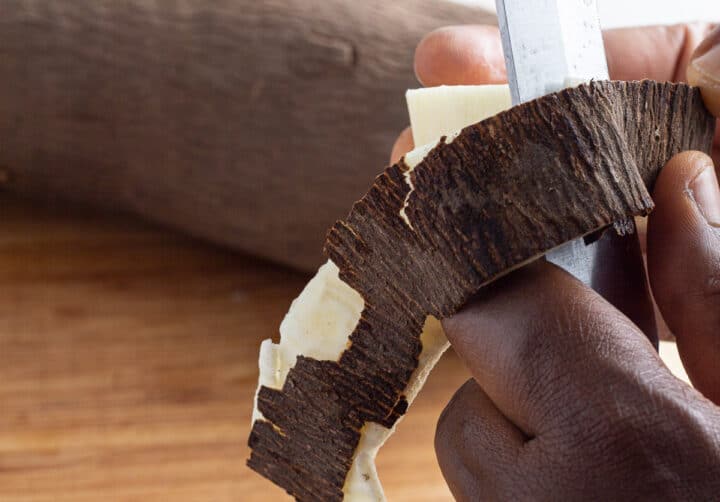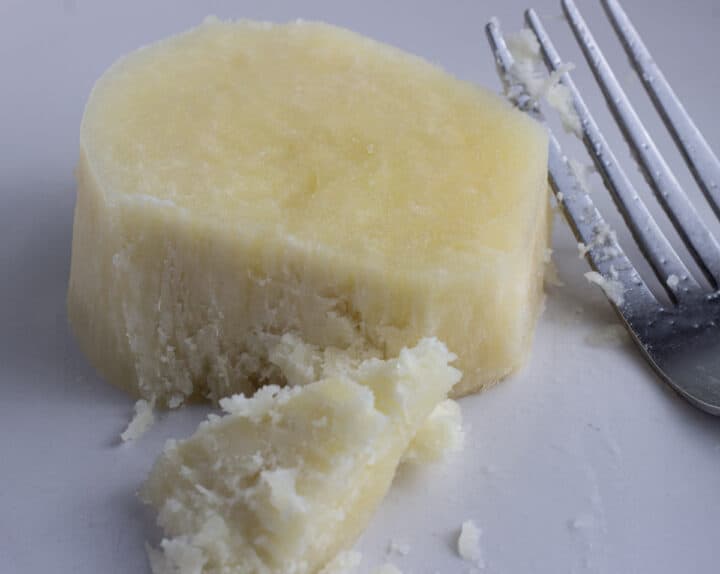African yams are edible tubers, which are a staple food in West Africa. They are versatile and can be prepared several ways to make different yam dishes. Boiled yam is one of the most consumed dishes from this tuber crop; many other dishes call for it as an ingredient. This is why I am sharing this post on how to cook African yam.

What is African Yam?
The term African yam refers to some members of the genus Dioscorea, mainly white yam (Dioscorea rotundata) and yellow yam (Discorea cayennensis). Other types of yams are consumed in Africa, but the white yam is most commonly consumed. There are also different cultivars of African yams, hence why we have Puna yam, Nigerian yam, Onitsha yam, Guinea yam etc.
In some parts of West Africa, yam has important socio-cultural significance. For example, in some parts of Nigeria, a traditional marriage ceremony is not complete without an exchange of yam between the two families. In fact, In Igboland in the Southeast of Nigeria, yam is referred to as the “king of crops”, and they celebrate “new yam festival” annually at the end of the rainy season.
African yam is quite versatile. It can be boiled, baked in the oven, fried in oil or roasted. It is sometimes pounded into a dough-like format (Iyan) or dried and ground into flour, that is cooked into a thick paste (amala) and consumed with soup. It can be made into a porridge (asaro), grated and fried into fritters (ojojo), or made into pepper soup or a curry.
Differences Between Yam And Sweet Potatoes
What we refer to as yam in West Africa is different to what is referred to as yam in other parts of the world. In the US, for example, purple and orange sweet potato varieties are called yams.

Yams and potatoes are both edible root vegetables, but the similarity ends here. Yams are larger, have rougher skin, are not as sweet, and usually have more starch than sweet potatoes. Sweet potatoes tend to have a long and tapered appearance, and you can easily remove the skin with a peeler; you need a knife to do the same job with yam.
What Does African Yam Look Like?
There are some differences in the appearance of African yam, but generally, the tubers are long with a dark brown color. Yam tubers generally have a rough skin with some cultivars having “bristly” appearance.
More mature yams have more shriveled skin and a slightly sweet taste due to the water content drying out. While newer yams have a slightly smoother skin which peels off easily. In comparison, newer yams have a slightly smoother skin which peels off easily.

Cooked yam is denser, starchier and more crumbly than a potato. Similar to a potato, it can be used in endless ways.

How To Boil African Yam
This African yam recipe is basic and is usually the first step in preparing yam dishes like asaro, pounded yam etc.
Here are the ingredients you need...
Yam tuber
Water
Salt
A few notes about yam…
Yam tubers are usually big and not the easiest to wash in kitchen sinks. There is no need to wash before peeling unless it has just been harvested and covered in soil. The tuber is more prone to spoilage in the presence of moisture. It is best to cut off the quantity you need, then peel and wash before cooking.
How To Peel It
You must remove the skin before cooking unless you are roasting African yam tubers. There are different ways of doing this, but I find it easier to cut the yam into slices before peeling and use either of the two methods below.
- Hold the yam slice in your non-dominant hand; hold the knife on the other hand. Position the knife as if you want to peel an orange or an apple and make a cut into the skin of the yam. Rotate the yam slice slowly against the knife so the blade removes the skin as it moves.

- Place the yam slice flat on a chopping board, use a knife to cut off the skin as shown below.

Take extra care when peeling, as raw yam can cause itching. Handling should be as minimal as possible.
Similar to other vegetables, yams tend to undergo enzymatic browning when the surface is exposed to oxygen. This is why the colour darkens sometimes after cutting. Place the yam slices in water immediately after peeling to reduce this browning effect
How To Cook It
Cut off one of the ends of the yam and cut into slices.

Peel the slices and place in a bowl of water to prevent browning.
Wash the yam slices under running water to remove all sand and dirt.
Place in a saucepan filled with water making sure the water covers the yam. The pot should not be too full as yam tends to boil over. Leave some space in the pot to allow for this.

Add a pinch of salt. You only need a little salt not to overpower the delicately sweet taste of yam. More mature yams have more sugars and taste sweeter than new yams. If you are cooking new yam, you could add a little sugar for added sweetness.
Place over medium heat and allow to cook. New yam will be ready in about 15 mins, while more mature yam could take between 20 – 25 mins.

I usually check with a fork, and when it goes through the yam, easily to break up a piece. I know the yam is done. You can also taste, and like potatoes – you will know whether the yam is cooked or not.

Recipe FAQ & Notes
They are usually available to buy in African and Asian stores. You can also buy on Amazon.
Check for signs of damage to the tuber. Holes and cracks are usually an indication of damage. Press the tuber; you want firm flesh with no soft spots. Softness is an indication of a rotting tuber.
Yam tubers are usually big, and unless you are cooking for many people, you are not likely to use up the whole tuber at once.
You can store whole or left-over yam in a dry, well-ventilated place. New yam is likely to spoil more quickly than dry yam because of the high water content, therefore, do not keep it for more than a few days.
I find that yams spoil quicker here in the UK, than in Nigeria for some reason, so I freeze excess yams. Freezing is an excellent way to preserve for a more extended period. To do this, place peeled yam slices in a ziplock bag. Flatten the bag and close it before keeping in the freezer. You will cook straight from freezing and cannot separate the pieces, so keep a portion per ziplock.
No, yam does not need to be soaked before cooking.
Boiled African yam is quite dry to eat, but it goes well with sauces and oils. The simplest way to enjoy it is with a drizzle of red palm oil or groundnut oil. You can also eat it with ata dindin (fried stew), fried egg, Efo riro, , garden egg stew, corned beef stew or shito sauce like the Ghanaians.

Related Recipes
Some African yam recipes to try…
Yam porridge with plantain (Asaro)
How To Cook African Yam
Equipment
- Saucepan
- Knife
- Chopping board
Ingredients
- ½ tuber Yam medium
- Salt a pinch
Instructions
- Cut off one of the ends of the yam and cut into slices.
- Peel the slices and place in a bowl of water to prevent browning.
- Wash the yam slices under running water to remove all sand and dirt.
- Place in a saucepan filled with water making sure the water covers the yam.
- Add a pinch of salt.
- Place over medium heat and allow to cook. New yam will be ready in about 15mins, while more mature yam could take between 20 – 25 mins.
- Remove from heat.


[…] West African and the Caribbean Islands. If you are not familiar with African yam, please check this post […]